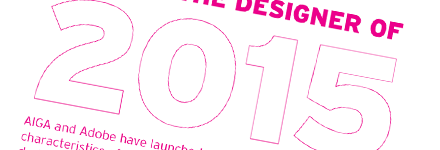Defining the Designer
Tom Osborne, Former VP, Design
Article Category:
Posted on
What is it about designers? Who are we and why are we the way we are? Answers to these questions might come in many different forms. Like people in general, no two designers are alike. That being said, my guess is that just about anyone reading this will have an answer in some shape or form that describes someone they know who calls him or herself a designer. I'm not a psychologist nor do I claim to be an expert on defining designers but I can draw upon what I know about myself and offer my thoughts about other designers that I have met over the years.
For one, we designers have egos. We don't outwardly brag about ourselves too often but we do bear a certain quiet confidence. Understanding this is easier than one might initially think. For many of us, we've been told how talented we are from an early stage in life. It doesn't take much to recognize when someone is creatively gifted in one way or another and its always a nice compliment that someone can offer and feel good about. Once you've heard this enough times you begin to believe what others are saying and thus an ego boost begins. You also begin to recognize when someone is being real and is understanding of the true depth to your talent. This becomes a self-realization of sorts. Am I as talented as people say I am? Am I better than what is perceived?
Another interesting character trait is that despite egos designers can be reticent, reserved or known to internalize thoughts. Could this be from our own self recognition that we are a little different from what many would consider normal? After all, if you believe what I said about compliments coming early in life then you'll also understand how that can begin to isolate or call attention to someone in awkward ways. This begins to become a part of you as you continue to think differently about everything in life.
Designers are good problem solvers. Because we think differently about things, we begin to think up ideas and solutions to everyday problems. Our thoughts aren't always the most logical or cost effective but a designer can more often than not offer valuable alternatives to more conventional ways of thinking.
Designers are idealists. We know from our problem solving experience that there are always better ways qualitatively of doing things. We believe life can be better, more rewarding and we believe we can help identify ways to achieve such challenging goals. Environmental, ecological and political issues become a part of this. There is always hope and optimism in this regard.
Of course these are generalizations and don't nearly begin to disect all that is unique about designers. There's no one square on a Myers-Briggs grid that we can lump a bunch of designers and be right. We'll find designers all over the grid in a personality test. I simply care to learn more about the peculiarities of design personalities by soliciting some of my own thoughts. You may think differently. Perhaps we can use some findings to share with our colleagues in strategy, development, marketing or other facets of business and life to find better ways of working with designers.

Designer Roles of the Future
The AIGA, in partnership with Adobe, attempts to dig deeper with their recent poll attempting to define the designer of 2015 by capturing predictions from the masses on what designers will be like 7 years from now. The intent seems to be in search of providing helpful guidance to professionals and employers as well as students and scholars to prepare for new ways of thinking about design and what it means to those around us (and of course both the AIGA and Adobe have a watchful eye on the future of design). Focusing on competencies and trends, here are some questions and descriptions of trends the poll asks and suggests:
Competencies: What are the essential competencies expected of individual designers?
Trends: What are major trends we see affecting the practice of design? Here are some as defined by the poll:
- Expanded Scope: As the scale and complexity of design problems expand, designers must address them at the systems level, even when designing individual components.
- Wide and Deep: Designers must be able to draw on experience and knowledge from a broad range of disciplines, including the social sciences and humanities, in order to solve problems in a global, competitive market of products and ideas.
- Break Through: Shifting from an information economy to an attention economy (involving communication design, information design, experience design, service design).
- Sharing Experiences: Shifting from the idea of customers/users to co-creators (mass customization); rise in transparency of personal and professional lives (social networking, blogging, etc.)
- Targeted Messages: Shifting from mass communication to more narrow definitions of audiences (special interest design) requiring designers to understand both differences and likeness in audiences; growing need for reconciliation of tension between globalization and cultural identity.
It is strange to think that as communication becomes more global we'll also need to think about smaller target audiences. The planet is large and diverse but there are similarities among humanity that while universal become unique among different personalities both by nature and culturally. The AIGA plans to release the results of the poll in June of 2008 (within weeks of this post). I'm sure I'll be one of many looking to see the findings. Time to put some of those ideals to practice among many problems to solve. Let's get started.
How would you describe designers you know and what do you see as characteristic of the role of designer in the next 7 years?